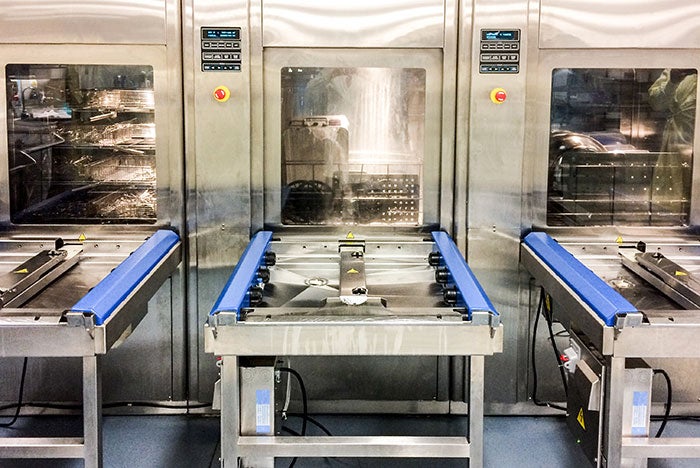Tapping into water conservation strategies

Water-saving strategies can be applied to sterilizers found in the sterile processing departments of health care facilities.
Health care facilities operate 24/7, with a continual stream of people working and visiting, and life-saving procedures being performed. Focusing on water efficiency in these buildings is becoming increasingly urgent due to the volume of water they require.
Health care facilities are the third-largest water consumers of all buildings in the United States, according to the Environmental Protection Agency’s (EPA’s) Energy Star data, and are responsible for 7 percent of water use among all commercial buildings.
Because the occupancy patterns and use of health care facilities varies widely, from inpatient teaching hospitals with intensive care units to stand-alone emergency departments, water use likewise varies widely, enabling flexible and adaptable ways to conserve potable water use at the building level.
Calculating payback
Water conservation should bring payback into health care facilities, but this is disputable. Of the three utilities — water, energy and sewage conveyance — water historically has been the least expensive. This leads to a conflict: Facilities need to focus on return on investment while maintaining ecological concerns in this situation.
Low-flow fixtures and other conservation methods are excellent solutions to reduce water use but, depending on the strategy implemented and the utility’s water cost, the estimated payback can extend well beyond 10 years, so is often prioritized behind other more rapidly feasible improvements.
Recent drought conditions across the country are beginning to change this trend. In some areas, the price of water has been rising significantly, approaching more costly sewage conveyance rates. A mutual benefit of decreasing water use in a facility is a reduction in the amount of water leaving the building, reducing both water and sewage conveyance costs.
Water reduction has another hidden benefit: energy reduction. Buildings are an ecosystem. If something is changed, there is a measurable effect somewhere else in the facility. When changes are made to reduce domestic hot-water use, the domestic hot-water boiler capacities and associated system piping need is reduced as well, saving installation and operating costs.
Right-sizing HVAC equipment leads to less makeup and blowdown water required for the cooling towers; and incorporating condensate recovery will bring benefits. Changing the cooling tower from an open-circuit to a closed-circuit cooling tower can reduce the makeup water further. These savings are not limited solely to the building systems.
You may also like |
| 2015 Sustainable Operations Survey |
| California hospitals conserve water as drought drags on |
| How to plan for water-system outages |
|
Taking it one step further, using a geothermal closed-loop system as heat rejection for cooling towers would minimize the water required for makeup. Energy- and water-conservation methods can be implemented together for greater savings.
What happens when a health care facility is designed with both energy and water efficiency in mind? A snowball effect results. Low-flow water fixtures lead to smaller pumps and boilers throughout the facility. Reducing makeup and blowdown also reduces energy and water costs.
When all of these water conservation methods are combined, savings are seen upstream of the facility at the utility plant. It takes approximately 25 gallons of water (potable and recycled) to generate 1 kilowatt-hour (kWh) of electricity.
Performing a simple calculation for a 200,000-
square-foot hospital with a median Energy Star portfolio manager Energy Use Intensity of 196.9 kilowatt-British thermal unit (kBtu) per square foot per year, the facility would require 11.54 million kWh of electricity per year.
Assuming 25 gallons of water per kWh, this facility requires up to 288.5 million gallons of water to be used at the utility plant. Imagine if 10 hospitals reduced their water and energy use by merely 10 percent each — the effect it would have at the utility plant would be significant. Quantifying this, there would be a savings of 288.5 million gallons of water, or one entire hospital’s average use being saved — or the quantity needed to fill 28,850 average-size swimming pools.
Domestic systems
According to the EPA’s Energy Star 2012 reporting, restrooms and domestic uses account for 35 percent of the overall potable water use in health care facilities, making them the single largest users. Thanks to programs like the EPA’s WaterSense and the U.S. Green Building Council’s LEED, the plumbing industry is accustomed to low-flow fixtures in restrooms, including dual-flush toilets and low-flow urinals, sensor faucets and shower heads. These fixtures are regularly available on the market, generally accepted by health care facilities departments, and can help a facility to reduce its domestic water use by at least 20 percent.
However, if hand-washing sinks are included in the “domestic” heating, the opportunity to use a low-flow substitute fixture is not as readily available. In the mid-1800s, hand washing was found to be the single most important method of infection control — and the Centers for Disease Control and Prevention still agrees.
Consequently, health care building codes and sustainable rating systems exempt caregiver hand-washing sinks from water flow requirements. While facilities professionals would never want to limit hand washing in a health care environment, the reality is many hand-washing sinks for caregivers are located throughout a health care facility – in areas such as exam rooms, patient rooms and nurse stations.
So, while present-day health care standards still list hand washing as the most important means of infection control, these plumbing fixtures still use potable water and contribute to the water use of the building. The more prominent use of antibacterial foams in hospitals has been an effective means of continuing the best practice of hand washing while simultaneously reducing water use.
Heating and cooling (HAC) systems
The next big potable water user in a health care facility is the HAC system. Depending on the climate, this can be the largest water consumer. Not only are health care facilities generally large, but health care design standards require HAC systems to cool and dehumidify large amounts of outside air to accomplish code-required air changes in many space types throughout the building.
Especially in hot and humid climates, this translates to significant amounts of makeup water at the cooling towers — a large cooling plant’s heat rejection devices. Generally, when potable water is being used for an activity in which it does not make contact with a human, such as cooling tower makeup, there is an opportunity to look at a non-potable water source to accomplish the same result.
In the case of cooling towers, the need to properly maintain these large, critical pieces of equipment often drives the decision to stick with potable water; however, the use of non-potable water for the same function, when the quality of available non-potable water allows, can greatly reduce the total potable water use in a large health care facility.
When non-potable makeup water is not an option, facilities can turn to other water-saving strategies. Recovered condensate at the air-handling units can be redirected to the cooling towers for makeup water, resulting in as much as 25 percent potable water savings. Maximizing the cycles of concentration at the cooling towers, minimizing evaporation through drift eliminators, phasing out old cooling towers, and automating the blowdown can all lead to significant water savings.
Because water and energy can be localized issues, design and facilities teams need to be mindful of balancing the opportunities to save water with the cost of energy when considering alternative technologies.
Medical equipment
The 2012 Energy Star report results list medical equipment as the third largest water user in a health care facility. The type and quantity of medical equipment varies greatly among facilities but certain equipment is generally common to all.
Autoclave steam sterilizers are widely used to decontaminate medical equipment for reuse, with high-temperature steam inside a closed chamber.
As the steam cools, it condenses into hot water and is generally sent down the drain and into the municipality’s sanitary system. However, to avoid the microbial growth that can occur with higher-temperature fluids and the problems this can cause the sanitary pipe system, municipalities tend to limit the temperature of water entering their systems.
For this reason, hospitals temper the autoclave waste water with tap water before it goes down the drain. In some cases, these autoclaves run 24 hours per day. Since the tempering water does not make human contact, the preference would be for it to be from a non-potable water source, such as reclaimed water.
If this is not possible, then water reduction can be realized through controls that limit the flow of tempering water to only when the autoclave is releasing water. Controls help realize water savings in a reverse osmosis system as well, limiting backwashing of the filter with potable water when needed based on a measured pressure differential across the filter.
In many cases, this backwash is performed on a timed basis, which can unnecessarily backwash the filter with many gallons of potable water when cleaning isn’t yet necessary.
Food service equipment
Finally, food service equipment has the potential to be a large potable water user, with the bulk of the water use typically seen at the dishwashing and food waste disposal stations. The EPA’s WaterSense program only governs pre-rinse spray valves when it comes to kitchen equipment; however, all Energy Star equipment is also required to be WaterSense-compliant.
For this reason, specifying Energy Star appliances when selecting dishwashers, ice makers and steam cookers is also a good way to ensure that the appliance will use 20 percent less water than its noncertified counterpart.
For food waste, a tremendous amount of water savings can be realized by implementing a composting program at the facility, or participating in an existing local program. Because this is not always available, using food pulpers instead of food disposals will result in potable water savings in the kitchen.
Measurement and implementation
It is important to measure all of these conservation strategies. Ideally, submeters are placed at each major piece of equipment. LEED requires submeters for measurement and verification credits, and submeters can help to identify leaks within the system when water use fluctuates for an undetermined cause, alerting building operations for maintenance.
There are useful references for incorporating these actions. The EPA offers the WaterSense labeling program, which is a product and service label program demonstrating at least 20 percent water reduction over similar products. It applies to bathroom faucets, toilets, urinals, showerheads, irrigation controllers and prerinse spray valves.
The EPA also publishes “WaterSense at Work,” a useful resource for all facilities. It contains best-management practices for water reduction and includes retrofit options, payback analysis and estimated water savings. Practice Greenhealth has the health care-specific “Less Water Program,” which outlines processes for developing short-, medium- and long-term water conservation goals for health care facilities.
Additionally, when comparing benchmarks, the Energy Information Administration has the 2012 Commercial Buildings Energy Consumption Survey, a representative source of energy- and water-related analyses for the nation.
Finally, the Sustainability Roadmap for Hospitals website developed by a few of the American Hospital Association’s personal membership groups, including the American Society for Healthcare Engineering and the Association for the Healthcare Environment, offers an outline for setting up a hospital water-management plan.
An important role
Water plays an important role in health care facilities — from patient care and safety to daily operations — which causes them to use a significant amount of it.
When planning to implement conservation strategies, it is imperative to discuss all options with a health care organization and users, ensuring that all parties understand the strategies and the reasons for implementation.
Kristy M. Walson, P.E., LEED AP BD+C, BEMP, is a principal/sustainability consultant and W. Burns Bradford, P.E., LEED AP BD+C, is an associate/engineer at TLC Engineering for Architecture in Orlando, Fla. They can be reached at Kristy.Walson@tlc-eng.com and Burns.Bradford@tlc-eng.com, respectively.





